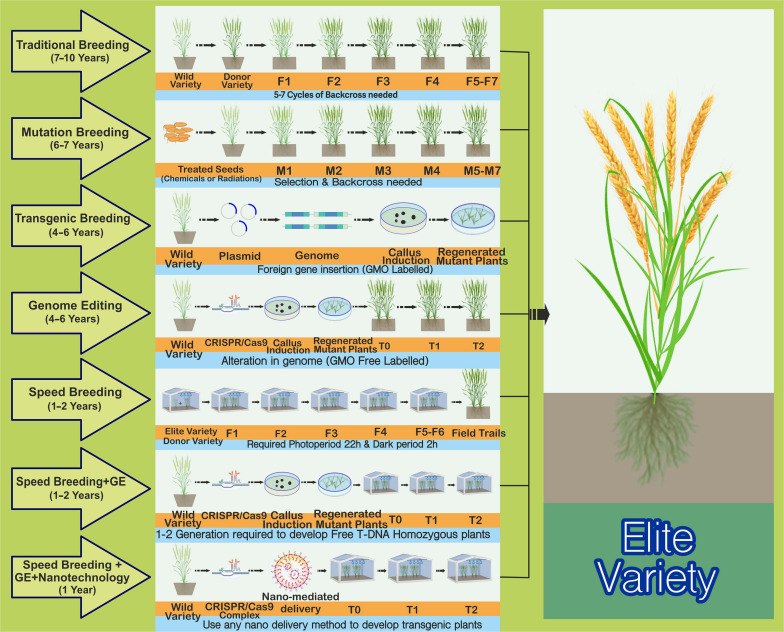FIGURE 1.
Comparison of the most commonly employed plant breeding mutagenic and time-saving strategies for crop improvement. Traditional plant breeding is used to enhance plant characteristics. The complex successive backcrossing and rigorous selection process of the elite recipient’s parent line with a donor line leads to the development of an outstanding progeny with desired traits. This is a time-consuming, laborious, and less-effective technique. Mutation breeding, also known as “variation breeding,” refers to seeds being treated with chemicals or radiation to produce mutants with suitable characteristics to develop elite cultivars. It would require 6–7 years to produce desirable outcomes and is also a time-consuming process. Random mutations in the genome are one of the critical drawbacks and disadvantages of this strategy. Transgenic breeding has been successfully utilized to improve various crops with different traits by importing a gene of interest from one plant genome to another. These are regarded as genetically modified organisms (GMOs) owing to the insertion of foreign DNA/elements into the genome, and one of the biggest problems with GMOs is their comparative lack of acceptance among the public and a large group of plant scientists worldwide. Genome editing (GE) methods, such as the CRISPR/Cas9 method for trait improvement, provide a cost-effective, stable, time-saving, and less laborious solution than other existing techniques. Moreover, these methods can also be used to evade the GMO law, labeling the products as “non-GMO” because of the absence of any foreign DNA. Speed breeding that extends the photoperiod (22 h with 2 h of darkness in a 24-h diurnal cycle) improves the flowering time compared with that under normal conditions, potentially achieving four to six generations per year rather than the single generation achieved under normal conditions. Regarding photoperiod, continuous light is another option, but the dark period slightly improves the plant health. The optimal temperature regime (maximum and minimum temperatures) should be applied for each crop. This presents the best strategy for developing elite organic varieties within 1–2 years. The GE technology could also be improved by using speed breeding to establish a transgene-free plant within 1–2 years rather than waiting for an entire season under average growth. Another strategy involving nanotechnology and a combination of speed breeding and GE is proving reliable for speedy crop improvement. Here, plants can be grown under speed breeding conditions, and NPs coated with DNA, RNA, or RNP can deliver CRISPR reagents into meristematic cells. Transgene-free edited plants are obtainable from the edited tissues, either sexually or asexually.

